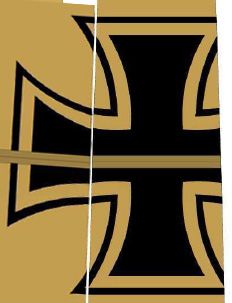I am currently drafting some decals for my 1/144 Zeppelin, and I've hit a bit of a stumbling block.
We all know what an Eisenkreuz looks like, I hope. But the card model I'm basing my scratchbuild on has a weird, skewed version where the 'arms'extend onto the adjacent nose panels:

Now, the only explanation I can think of is that this is to correct for perspective distortion; ie, so that the cross appears properly square when viewed from below, rather than distorted from wrapping around the tapered nose. Viewed flat, it looks really weird and wrong; when applied to the 3D nose, presumably it would look "correct".
The question is...
did the Germans actually USE perspective correction on any markings in WWI? Given that everything was painted by hand, it seems like it'd be a whole lot easier just to use the 'normal' proportions and have an ever-so-slightly mis-shapen cross, rather than calculate the geometry to correct the minor distortion on a 17' cross that's flying at 13,000'. At night.
Then again... Germany.
